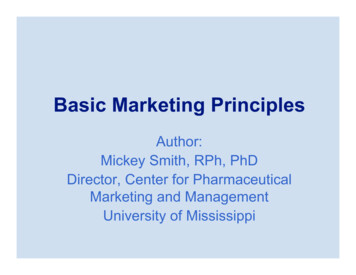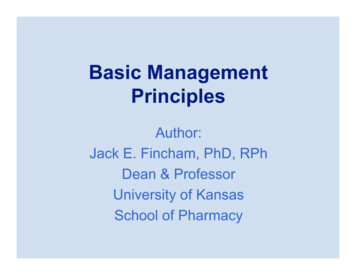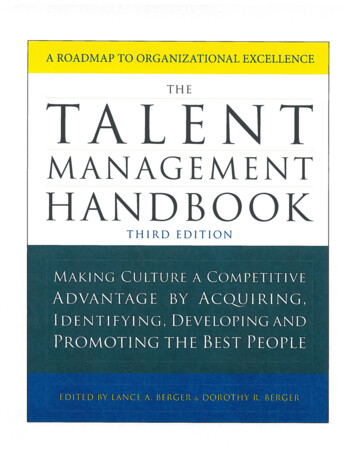
Transcription
Basic Marketing PrinciplesAuthor:Mickey Smith, RPh, PhDDirector, Center for PharmaceuticalMarketing and ManagementUniversity of Mississippi
Learning Objectives Define “marketing” in official and “real world”terms List at least five viable market segments Differentiate by example between services andphysical products Describe the interaction among and betweenthe four elements of the “marketing mix” Enumerate the ways “positioning” combines theother elements of the marketing mix Identify possible competition for your ownpharmacy
Definitions The process of planning and executing theconception, pricing, and services to createexchanges that satisfy the individual andorganizational (pharmacy objectives) Creation and delivery of a standard of living Fundamental social process which evolveswithin a society to facilitate the effective andefficient resolution of society’s needs forexchange of “consumption values”
Requisites of Success Get and keep patients In a way that is cost consistent withpatient evaluation Survive and profit regularly Define purpose, plan and communicate Develop a system of rewards andsanctions
The Marketing Mix ProductPricePlacePromotion
Target Market Variables AgeEducationGenderNational originLife style Income Race Religion Place of residence
Differences Between Servicesand Products Services are oftenintangible - acts, deeds andcannot be physicallyprocessed. Value lies inexperience and no transferof titleUsually perishable, unusedportions cannot be storedQuality cannot beseparated from the serviceproviderVary in quality over timeand are difficult tostandardize over time Products are often tangibleobjects or things. Value liesin ownership and use andtransfer of title takes placeCan be stored, and unusedportions can be used laterQuality can be differentiatedfrom the channel member’squalityProducts can bestandardized and massproduction and qualitycontrol are possible
Product MixThe assortment of goods and servicesthat must be maintained in order tomeet patient needs
Service as a Product A service is a product at the instant ofdelivery; it can be created in advance or heldin readiness A service cannot be centrally produced,inspected, stockpiled, or warehoused.Usually delivered to the customer, by peoplebeyond the immediate influence ofmanagement The “product” cannot be demonstrated, norcan a sample be sent for approval
Service as a Product The person receiving the service has nothingtangible, value depends on personalexperience The experience cannot be sold or passed onto a third party A service cannot be recalled or repeated Quality assurance must happen beforeproduction rather than after production, as inthe case of products
Service as a Product Delivery of the service requires humaninteraction; buyer and seller must come incontact in some relatively personal way tocreate service Receivers’ expectations are integral tohis/her satisfaction, and are largelysubjective The more people the customer mustencounter during the delivery of the service,the less likely it is that he/she will besatisfied with the service
ResultsThe final product class is theanticipated results of the goods andservices
ProductThe benefits or positive results(outcomes) that your patients deriveout of dealing with you and using theservices you offer them
Customers’ Perceptions ofProducts Revlon: Cosmetics sell “hope” Black and Decker: Drills sell “holes”
New Paradigm Pharmacist as a therapeutic “agent”
Customers’ Perception ofPharmacistsYour pharmacist: helping you take careof yourself
Pricing Considerations Nature of the target market(aforementioned) Nature of the competition Cost of merchandise (IE, successfulbuying practices by the pharmacymanager) Familiarity of the customer with priceranges
PriceThe costs or negative effects thatpatients must bear in order to dobusiness with you, using your servicesin the way that you offer them
What Is a “Discount” Really?
Pricing One respects older people andbelieves they should get specialconsideration because of their agealone. That may not be very goodbusiness, but it’s a fine human gesture
Pricing Older people have lower incomes andcan’t afford health care. Another finegesture, even though imprecise. Manyolder people can well afford theirhealth care. If one offers differentialprices based on ability to pay, age maynot be the best criterion.
Pricing One wants the good will of thesecustomers and discounting for seniorcitizens is price willing to be paid forthat. Now that is serious businessreason for setting prices.
Pricing It isn’t really a discount. It’s justadvertising. While many may engagein this practice, the risk of being foundout is rather great. More and morepeople know their medicines andcompare prices.
Pricing Older people use more prescriptionsand other health products than doyounger customers; their business isvaluable. Again, a sound businessdecision. Consciously or not thisdiscount is based on expectedbusiness volume. It’s not really an agerelated discount.
Pricing One must do it to meet the competition(all of whom are doing it). Another validbasis for pricing. Of course ifeverybody does the same thing thecompetition does on every competitivedecision, some non-price differentialadvantages may be overlooked.
The Pricing Process The pricing process involves 5 steps:– Setting price objectives– Setting a broad price policy– Developing a price strategy– Implementing the strategy– Making necessary adjustments (finetuning)
Competitive Objectives Meet the competitionBe the price leaderOffer the lowest priceIncrease sales volumesPrevent competitionNeutralize price through non-pricemeans
Financial Objectives Maximize short-run profitsMaximize long-run salesStabilize incomeMove high-margin itemsMove slow turnover itemsSustain a certain gross profit level
Market Objectives Build market shareBuild trafficEmphasize low price imageDesensitize customers to priceCreate attention and interestAchieve future growthMaintain current market share
Price Policy Options “One-price” policy Variable price policy
Reasons to Vary Prices forIdentical Goods Different acquisition cost Increased record keeping cost Cost of credit to the customer or a thirdparty Delivery costs Pilferage risks Frequency of customer buying
Pricing Strategies Cost-based Demand-based Competitive-based
Cost Considerations inDetermining Prices Advertising and other forms of promotionAll kinds of customer discountsReturnsDeliveryCredit and other costs of moneyAdministrative costsSelling expensesPilferage and shopliftingSecurity costs
Pricing StrategiesDemand-based pricing is related tothe patient’s willingness to pay
Price Elasticity and Inelasticity “Elastic” pricePrice 1.00, 100 units sold 100.00Price 0.50, 300 units sold 150.00Price 1.50, 50 units sold 75.00 “Inelastic” pricePrice 1.00, 100 units sold 100.00Price 0.50, 125 units sold 62.50Price 1.50, 75 units sold 112.50
PlaceThe hours location and physicalcharacteristics that make it possible,easy or difficult for patients to use yourproducts and services
Ways to Manipulate Place DeliveryParkingDrive-in windowsInterior design and atmosphericsExterior appearanceTelephone
The Telephone as an Asset Calls to increase patient compliance Calls to patients to assess patientprogress and satisfaction Calls to newcomers to the communityto alert them to your services Calls to old customers whose accountshave become inactive to determine thereasons
PromotionThe most important of the “P”s
AdvertisingAccording to the American MarketingAssociation:“Mass, paid communication, thepurpose of which is to impartinformation, develop attitudes, andinduce favorable action for theadvertiser.”
Why Advertise? Attract attentionInduce interestDevelop the desire to buy andActivate the sale
Advertising Appropriationand Budget Establish the objectives for advertising Determine the type and amounts ofadvertising necessary to accomplish theseobjectives Determine the overall cost of theadvertisement Schedule the advertisement day by day
Types of Ads Institutional - focus on the pharmacy’sservices Merchandising - emphasize productsand services
Selecting the AppropriateAdvertising Media Newspapers Radio Television
Newspapers Local newspapers - widely read Account for 30 percent of alladvertising dollars Disadvantage - circulation sometimesmuch larger than pharmacy trade area
Radio Can be more persuasive than print High degree of geographic andaudience selectivity Local radio-need repetition, brevity Lacks visual reinforcement
Television Most conspicuous advertising medium Products or services must have massappeal
Advertising Considerations Consider clearly defined marketinggoals Is advertising best medium toaccomplish your purpose? Or, wouldpublicity be a better option? Do you deliver what you promise?
Positioning Position - sum total of its product,price, place, and promotional activities
Positioning Do you match your position (assumingyou have found one)? Perception becomes reality
Service Strategy Distinctive formula for deliveringservice Vision plays an important role Judgment, creativity and the ability tothink on a global level - necessary to“see the forest for the trees”
Service Strategy Organizing principle allowing people inservice enterprises to channel theirefforts toward benefit oriented servicesthat make a difference in the eyes ofthe customer Concept that describes the value to beoffered
Service Strategy Being called back when promised Receiving an explanation of how aproblem happened Providing me with information so Iknow what number(s) to call Being contacted promptly when aproblem is resolved Being allowed to talk to someone inauthority
Service Strategy Being told how long it will take to solvea problem Being given useful alternatives if it can’t Being treated like a person, not anumber Being told how to prevent future aproblem Being given progress reports if aproblem can’t be solved immediately
Service Reliability –Recovery Link The problem reinforces a recurringpattern of previous shortcomings The recovery effort fails to satisfy thecustomer
Influencers ofQuality Assessment ReliabilityTangiblesResponsivenessAssuranceEmpathy
ComplaintsCustomer complaints:The least expensive consulting you canget
Complaints The average business never hearsfrom 96 percent of its unhappycustomersComplainers are more likely thannon-complainers to do business againwith the company that upset them
Complaints Of the customers who register acomplaint, between 54 and 70 % willdo business again with theorganization if their complaint isresolvedThe average customer who has had aproblem with an organization tells 910 people about it
Market Audit A methodical analysis of theoperations, tactics, and strategiesused in marketingA self-examination
Market ResearchThe most effective way to forpharmacists to find out the needs andattitudes of patients and thuseffectively market their services Self test (Figure 2): What you knowand don’t know about marketing Patient Survey Form (Figure 3): Vitalinformation for the people you serve orwant to serve
ConclusionMarketing pharmacy services andproducts - achieving patient satisfactionand your satisfaction!
Basic Marketing Principles Author: Mickey Smith, RPh, PhD Director, Center for Pharmaceutical Marketing and Management University of Mississippi. Learning Objectives Define “marketing” in official and “real











